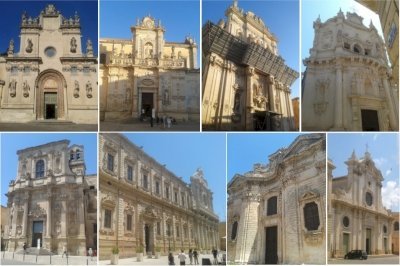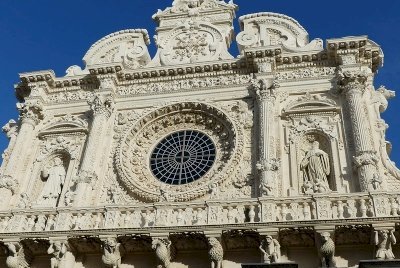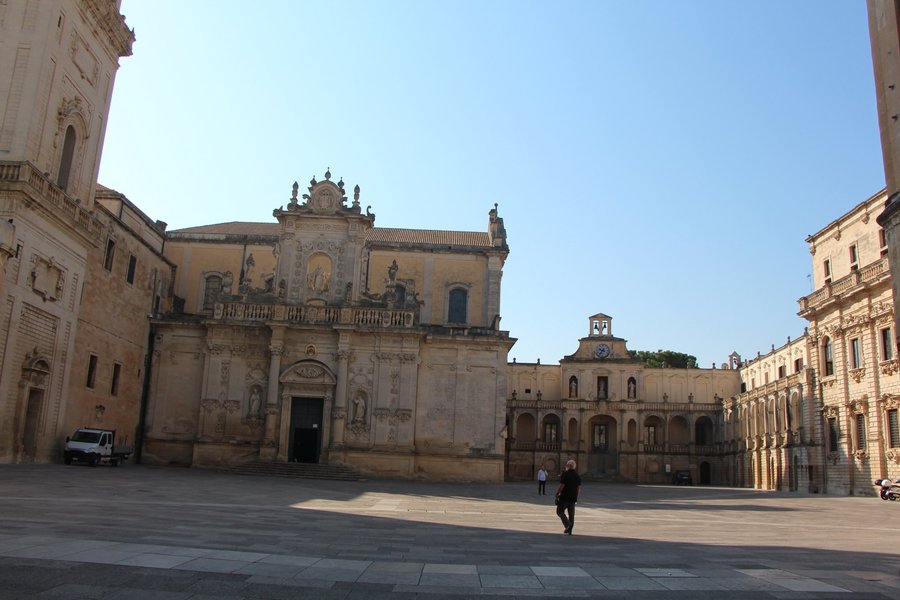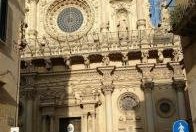Italy
Salento and the Barocco Leccese
Salento and the "Barocco Leccese" is a series of cities on the Salento Peninsula in south-eastern Puglia. The distinctive character of the cities comes from the architectural achievements associated with "Barocco Leccese," an artistic style that developed in Lecce and in Terra d'Otranto, between the second half of the 16th century and the end of the 17th century. Architectural elements of façades are crowded with decorations of human figures, flowers and animals.
Site Info
Official Information
- Full Name
- Salento and the Barocco Leccese (ID: 1149)
- Country
- Italy
- Status
-
On tentative list 2006
Site history
History of Salento and the Barocco Leccese
- 2006: Added to Tentative List
- Added to tentative list
- Type
- Cultural
- Criteria
Links
- UNESCO
- whc.unesco.org
All Links
UNESCO.org
- whc.unesco.org — whc.unesco.org
Community Information
- Community Category
- Religious structure: Christian
- Urban landscape: Post-medieval European
Travel Information
Recent Connections
News
No news.
Recent Visitors
Visitors of Salento and the Barocco Leccese
- Alexander Lehmann
- alicemears
- Ammon Watkins
- Argo
- Assif
- Bin
- butterflybird
- Christoph
- Claire Bradshaw
- Clyde
- CugelVance
- Dani Cyr
- Daniel Chazad
- David Berlanda
- Dimitar Krastev
- Doubanjiang
- Dr. Caligari
- Erik Jelinek
- Evgenii
- Federico P.
- Femke Roos
- Flexiear
- GeorgeIng61
- Hadrianus
- Jakob F.
- João Aender
- Jonas Kremer
- Jurre
- KentishTownRocks
- Klara Woodson
- Lisu Marian
- Little Lauren Travels
- Maciej Gil
- Matejicek
- Mateusz
- Mathijs
- MH
- Monica Tasciotti
- MoPython
- nan
- Paola Laura
- Philipp Peterer
- Pink Bunny
- Randi Thomsen
- Riccardo Quaranta
- Rick Ohm
- RobRos
- Roger Ourset
- Sclowitz
- Sergio Arjona
- SirLoydd
- stephanvermeulen
- Svein Elias
- Szabolcs Mosonyi
- Tarquinio_Superbo
- tony0001
- Tsunami
- WILLIAM RICH
- Wojciech Fedoruk
- Xiquinho Silva
Community Reviews
Show full reviews
I spent Pentecost Holidays (late May of 2023) in Lecce and it was my second visit of this place. Besides Lecce, I did a half-day trip to Nardo, and also did a stop in Ostuni during my return to Bari (I enjoyed direct flights between Prague and Bari!). Together with my 2018 visit of the Salento region (visiting of Lecce and Gallipoli), I could see almost all components mentioned on the worldheritagesite webpages. However, I did a small research and no explicit list of components are provided on official UNESCO pages and anywhere at all, maybe with an exception of Basilica di Santa Croce and Cattedrale di Lecce including Piazza del Duomo, which are absolute highlights of this TWHS. All of us know the trend that true treasures are usually diluted by mediocre components due to dubious purposes. During my internet research, I noticed recent attempts to refresh this almost 20 years old TWHS by the state party of Italy. So, we can expect anything...
About my recent visit: I confirmed my opinion from 2018 that Barocco Leccese deserves the WHS status, and I hope that not only isolated components (churches) but the entire urban landscape of Lecce and together with other places of the Salento region will be inscribed soon (my personal choice would be Lecce together with Nardo, however, S Agata in Gallipoli was fine as well). Visiting of Ostuni was big disappoint for me. I felt there like in hostile tourist trap and I had to …
Keep reading 0 comments
I visited this tentative WHS in June 2014 and November 2019. In June 2014 I had already visited Ostuni and Martina Franca, not knowing that they were 2 of the 11 locations that make up this tWHS. It was time to make up for this, so in November 2019 I explored the other 9 locations in Lecce, Nardò, Galatone and Gallipoli.
Ostuni is a pleasant place to visit although to me its highlight wasn't the Barocco Pugliese (which would be more apt as a title for this tWHS) but the great example of gothic architecture found at the former cathedral of Ostuni. It really reminded me of the Cathedral in Sibenik, Croatia. The Barocco Pugliese elements are scattered all over town but are more difficult to appreciate since most of Ostuni is white-washed. Perhaps the best example of baroque is the Chiesa the San Vito facade (the interior is currently closed for restoration works). On the other hand, Martina Franca is like a poorer and smaller version of Lecce and its monuments are almost entirely baroque. The highlight here was the Basilica di San Martino in Piazza Plebiscito. Unknowingly, in 2014 I had visited possibly the least impressive locations.
If you were forced to choose just one city/town to visit, this will undoubtedly have to be Lecce which actually gives the Barocco leccese its name. I spent a long weekend here and will be revisiting next year. One of the main peculiarities here is the bright white stone …
Keep reading 0 comments
I agree with Nan that Lecce with its Barocco is unique and the entire town with maybe 30 or 40 churches, baroque palaces and gates deserves to be included to the WHS list. In the proposal, there are only 5 churches/buildings included: basilica di Santa Croce (main facade under scafoldings now, but it is really a gem of Meditteraen Barocco), S Giovanni Battista (the main facade under scafoldings now), Santa Chiara, Piazza del Duomo (the ensamble is so delicate!), and SS Nicolo e Cataldo (I spent 3 days in Lecce but could not see this becase it is outside the town walls and I have not noticed that this complex is also listed in TWHS nomination...). I do not understand why only these churches were selected in Lecce, because I could read the studies that positions of main facades, shape of piazzas, direction of main streets, and possition of main monuments such as Campanile del Duomo or Colonna S Oronzo or Porta Rudiae have been carefully planned by baroque masters. It is also strange to me why the Title of the nomination is "Salento and the "Barocco Leccese"" even if the site is mostly about Barocco and not about Salento region.
I also visited Gallipoli with its cathedral, which is fully comparable to churches in Lecce but it has huge oil paintings covering the walls instead of usual frescoes.
I have no time to visit other sites, because I travelled by train and it has its own specifics …
Keep reading 0 comments
As a worldheritage traveller I have seen my fair share of Baroque sites, be it churches, palaces or towns. To be blunt, I wouldn't call myself a fan. As such I was really considering skipping on Lecce while touring through Puglia. Yet another Baroque town? In Italy? ...
As a worldheritage traveller you also know what sites are up for inscription in the foreseeable future. And a fellow traveller had posted a raving review on some site*. So I went. And to be blunt again: I am really happy I did, because Lecce is just this great. The town center is filled with scores of lovely churches and piazzas. And I experienced none of the fatigue I have come to expect from a Baroque town.
Apart from Lecce I also went to Ostuni and Martina Franca. Ostuni is situated on a hill and certainly a nice site. Martina Franca also has a nice old town. But in the end both cities pale in comparison to Lecce. Additional cities mentioned in the application are Nardo, Gallipoli and Galatone.
OUV
You can read up on Barocco Leccese, how the insular location of the Salento as well as shifting rulers created a distinct version of baroque. To me this is simply a special and unique site that deserves inscription, even though it's in Italy and even though I strongly biased against adding more Baroque sites to the list.
Getting There
Martina Franca is a short train ride …
Keep reading 0 comments